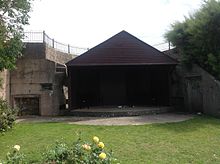Lumps Fort

 Clash Royale CLAN TAG#URR8PPP
Clash Royale CLAN TAG#URR8PPP
| Lumps Fort | |
|---|---|
| Southsea, England | |
 Entrance to Lumps Fort | |
 Lumps Fort | |
| Type | Fort |
| Site information | |
| Owner | Portsmouth City Council |
| Open to the public | Yes |
| Condition | Mostly complete |
| Site history | |
| Built | 1859–1861 |
| Materials | Brick, earth |
Lumps Fort is a disused fortification built on Portsea Island as part of the defences for the naval base at Portsmouth.
Contents
1 Early history
2 Palmerston-era reconstruction
3 Post-military use
4 See also
5 References
6 Publications
7 External links
Early history
Lumps Fort dates from the 18th century.[1] The earliest reference is in the records of the Board of Ordnance in 1805 which mention "Lumps Fort-three 32-pounder guns".[2]
By 1822 the fort was the site of a semaphore station on the semaphore line from London to Portsmouth. It was constructed here to avoid the smog of the town of Portsmouth which would impede direct optical communications from Portsdown Hill. The fort was out of use as a defensive fort by the 1820s and in 1827 part of the fort fell into the sea.[3] The semaphore station was closed in 1847 when the electrical telegraph took over.
Palmerston-era reconstruction
The fort was reconstructed between 1859 and 1869 as one of the Palmerston forts in the line of Portsmouth Harbour defences. It was designed to be fitted with 17 guns and had a barrack block at the rear to accommodate 100 men. It was not normally manned, with only a Master Gunner normally in residence at the Fort - in 1885 the Master Gunner was H Orchard.[4] It was also used by units of the Volunteer Artillery - the City of London Artillery Volunteers undertook gun practise from there in 1889.[5]

6-inch Hydropneumatic gun position, Lumps Fort (now Southsea Rose Garden, 2016
It was re-armed in the 1890s with three 6-inch rifled breech-loader Mk. IV guns on hydropneumatic carriages. These guns were taken away in 1906, but the fort was rearmed in 1914. It was then a beach defence battery and was armed with a 6-pounder Hotchkiss anti-aircraft gun. At the end of the World War I, it was demolished, leaving only an outline.[2]

Lumps Fort as seen from the air in 1945
Post-military use
The fort was bought by Portsmouth City Council in 1932.[6] Plans to develop the site were interrupted by World War II. In 1942, an elite special forces unit, the Royal Marine Boom Defence Patrol Detachment, was based in two Nissen huts at the fort and trained in the Solent opposite; they went on to conduct Operation Frankton, the "Cockleshell Raid" on shipping in Bordeaux harbour.[7]
After the war, it was planted as a rose garden,[6] with the Eastern part of the site becoming the Southsea Model Village[8]
Adjacent to the site is the Canoe Lake, constructed from a large area of marshland, which was opened on 17 June 1886 and used as a boating lake.[9] During World War II, the lake was used for experiments into countermeasures against magnetic mines[10]
See also
- Fortifications of Portsmouth
References
^ Corney, A (1965). Fortifications in Old Portsmouth-a guide. Portsmouth City Museums. pp. 10–12. ISBN 0001538136. OCLC 24435157..mw-parser-output cite.citationfont-style:inherit.mw-parser-output qquotes:"""""""'""'".mw-parser-output code.cs1-codecolor:inherit;background:inherit;border:inherit;padding:inherit.mw-parser-output .cs1-lock-free abackground:url("//upload.wikimedia.org/wikipedia/commons/thumb/6/65/Lock-green.svg/9px-Lock-green.svg.png")no-repeat;background-position:right .1em center.mw-parser-output .cs1-lock-limited a,.mw-parser-output .cs1-lock-registration abackground:url("//upload.wikimedia.org/wikipedia/commons/thumb/d/d6/Lock-gray-alt-2.svg/9px-Lock-gray-alt-2.svg.png")no-repeat;background-position:right .1em center.mw-parser-output .cs1-lock-subscription abackground:url("//upload.wikimedia.org/wikipedia/commons/thumb/a/aa/Lock-red-alt-2.svg/9px-Lock-red-alt-2.svg.png")no-repeat;background-position:right .1em center.mw-parser-output .cs1-subscription,.mw-parser-output .cs1-registrationcolor:#555.mw-parser-output .cs1-subscription span,.mw-parser-output .cs1-registration spanborder-bottom:1px dotted;cursor:help.mw-parser-output .cs1-hidden-errordisplay:none;font-size:100%.mw-parser-output .cs1-visible-errorfont-size:100%.mw-parser-output .cs1-subscription,.mw-parser-output .cs1-registration,.mw-parser-output .cs1-formatfont-size:95%.mw-parser-output .cs1-kern-left,.mw-parser-output .cs1-kern-wl-leftpadding-left:0.2em.mw-parser-output .cs1-kern-right,.mw-parser-output .cs1-kern-wl-rightpadding-right:0.2em
^ ab English Heritage - Lumps Fort"[permanent dead link]
^ Castles and Fortifications of England and Wales
^ Army List, HMSO, July 1885
^ The Graphic, 27 April 1889, p.445
^ ab Webb, J; Quail, S; Haskell, P; Riley, R (1997). The Spirit of Portsmouth: A history. Phillimore & Co. p. 66. ISBN 0-85033-617-1.
^ Ken Ford, The Cockleshell Raid – Bordeaux 1942, Osprey Publishing 2010,
ISBN 9781846036934 (p.11)
^ Ideas for the kids
^ Welcome to Portsmouth Canoe Lake
^ Ken Ford (p.12)
Publications
- Moore, David, 2013. Portsmouth Lines and Southsea Defences, Solent Papers Number 12, David Moore, Gosport.
ISBN 09570302-3-1
External links
- Victorian Forts data sheet
Next station upwards | Admiralty Semaphore line 1822 | Next station downwards |
Camp Down | Lumps Fort | HMNB Portsmouth |
Coordinates: 50°46′52″N 1°04′05″W / 50.7811°N 1.0680°W / 50.7811; -1.0680